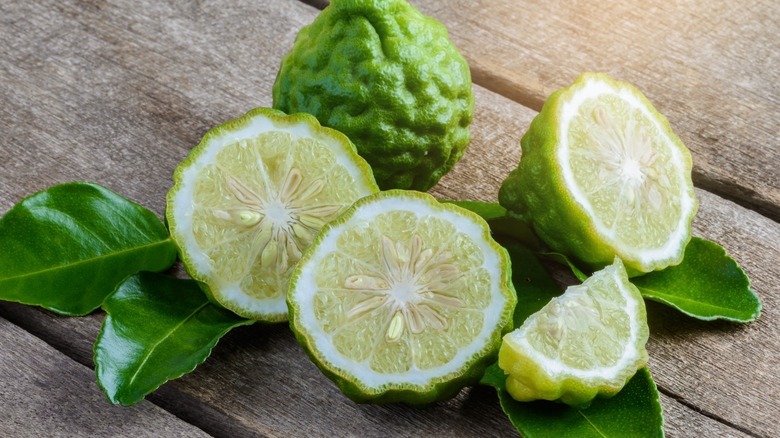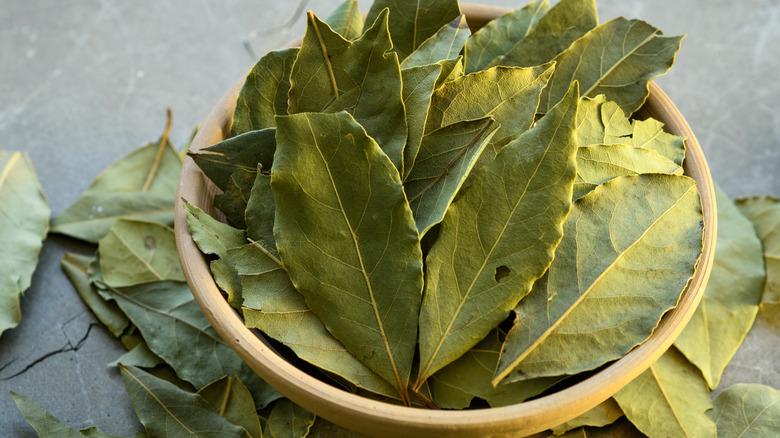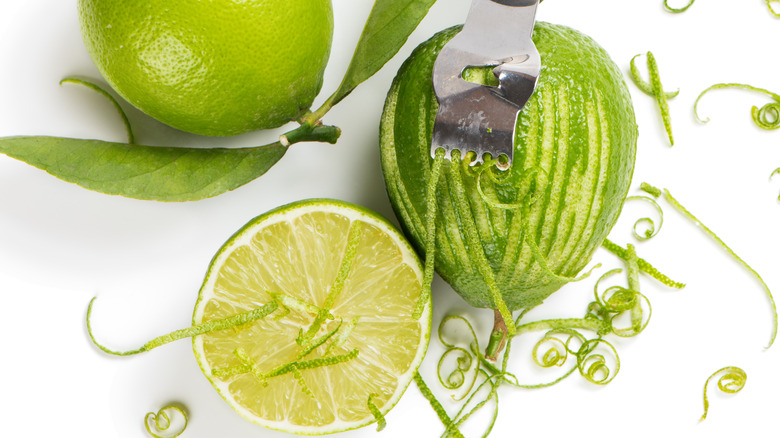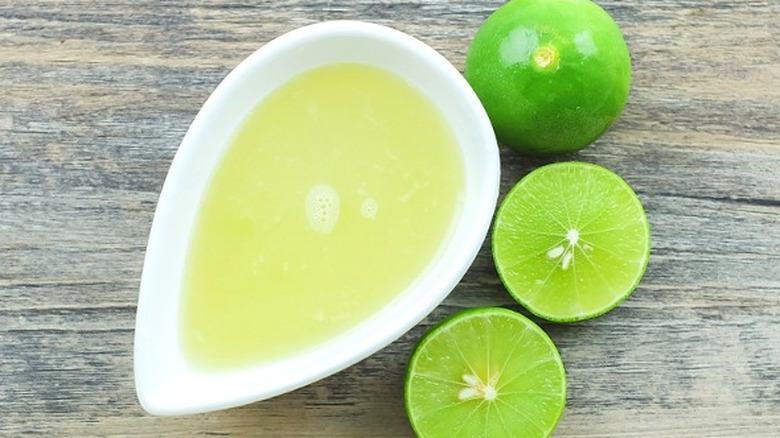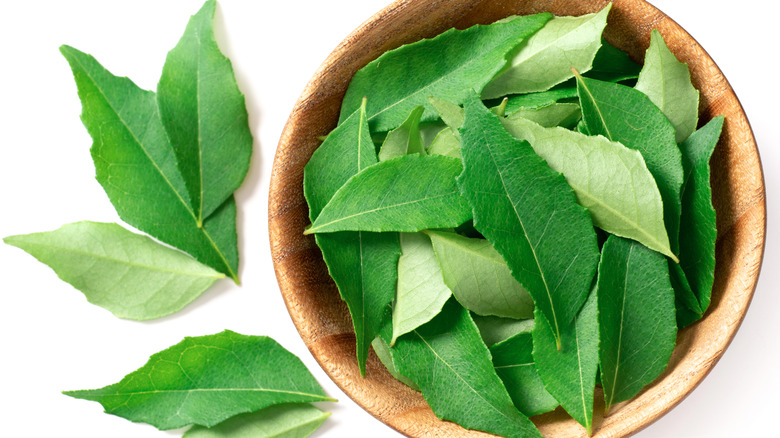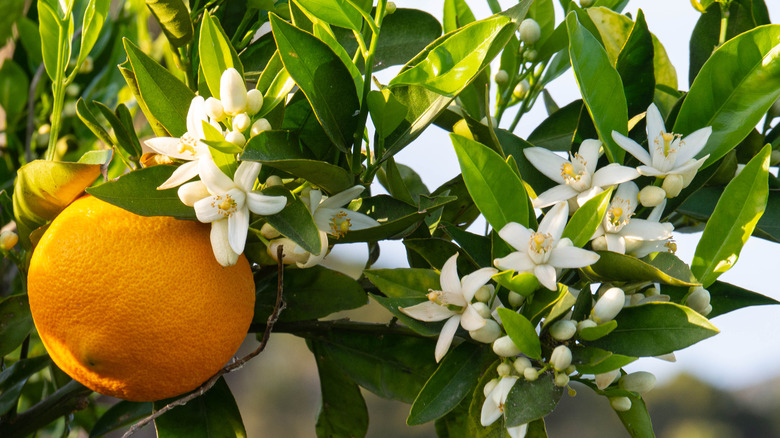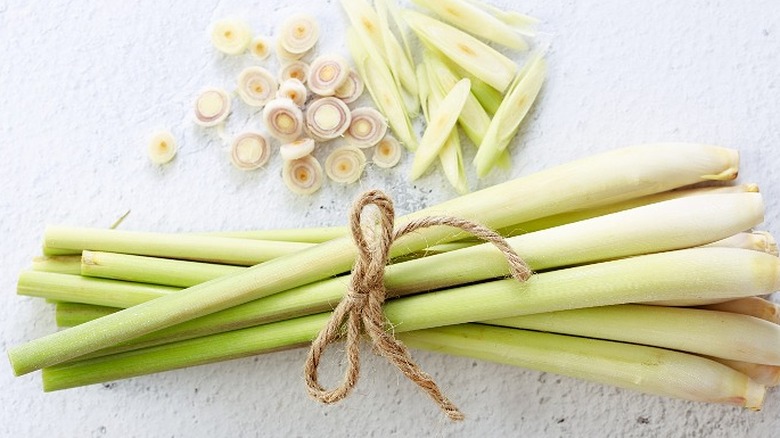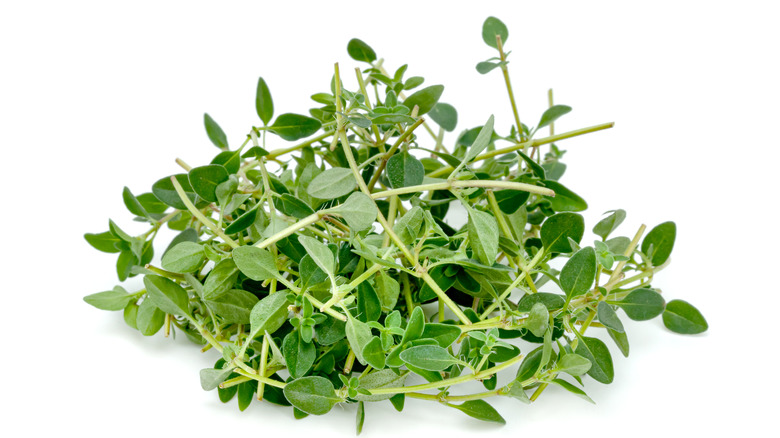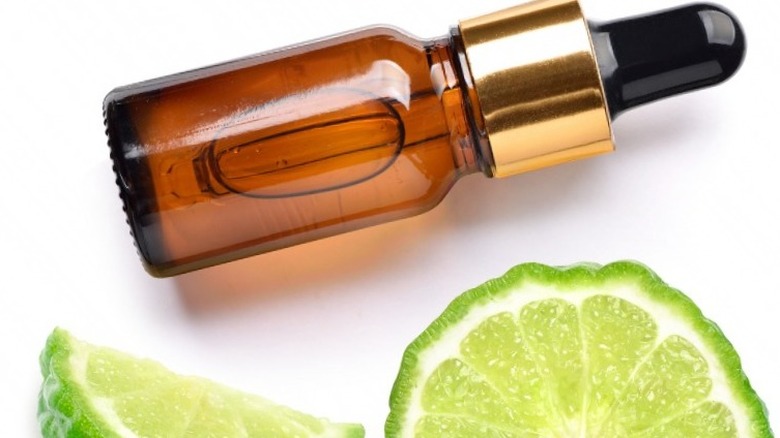The 8 Best Substitutes For Makrut Lime Leaves
We may receive a commission on purchases made from links.
Makrut lime leaves are an essential part of Thai cuisine and often found in other Southeast Asian dishes. The ingredient has a strong aroma and can be purchased fresh, frozen, or dried. Prized for their strong citrus flavor, it's the lime leaves that are used in cooking, not the actual fruit. Unlike other limes, makrut limes (Citrus hystrix) are so bitter that their main use is as a fragrance in cleaning products (via The Spruce Eats).
Something to watch out for is the way recipes refer to these lime leaves, with some using the term "kaffir." A "derogatory term in Arabic," shares Culinary Lore, the word was previously used by white South Africans, or Afrikaaners, to denigrate black South Africans. Today the leaves are known as makrut lime leaves, although there may still be recipes and online sources that use the derogatory term or names like "K-Leaves," lime leaves, or wild lime leaves.
It's important to note that these are different from western lime leaves, and the context of the recipe can help to distinguish which limes are required: Thai or other Asian recipes that call for lime leaves are likely referring to makrut lime leaves. Makrut may be difficult to find outside of online sources or specialty markets. For those that find the flavor too strong or don't have access to the ingredient, there are substitutes that can be used to attain a similar flavor.
1. Bay leaves
Bay leaves are a great option as a substitute for makrut lime leaves in savory dishes. You don't actually eat bay leaves — they are just used for seasoning a dish and then discarded before serving. For this reason they work best as a substitute in soups, sauces, and rice dishes where they can be used whole and easily removed.
Bay leaves lack the citrusy flavor of makrut leaves, but they do add complexity to recipes. The flavor of a bay leaf is piney, slightly minty, and peppery. Fresh bay leaves have the strongest scent, but dried bay is also quite effective — as long as it hasn't been neglected in your spice cabinet for years! Spiceography reccomends combining bay leaves with lemon or lime zest when substituing for makrut lime leaves; this will give your dish some of the citrusy flavor you're expecting.
Use the same number of bay leaves as makrut lime leaves called for in your recipe.
2. Lime zest
A natural substitute for one lime ingredient is to reach for another — in this case that's lime zest. Culinary Lore says that lime zest brings a bright and citrusy flavor to dishes that's a lot like that of makrut lime leaves. (It's fine to use Persian limes, which are the type typically found in grocery stores.)
According to The Kitchn there are several tools you can use to remove zest from whole limes, including a microplane grater, paring knife, vegetable peeler, and a citrus zester. Each tool creates different-sized bits of zest, so you'll want to choose your method based on the type of dish you're creating. Fine zest "melts" more easily into doughs and liquids, whereas larger pieces are great for garnishes. Whichever tool you use, remember when zesting limes to leave the white pith behind, since it's very bitter.
Culinary Lore suggests using 1½ teaspoons of fresh lime zest for each makrut lime leaf called for in your recipe. To create a more layered citrus flavor, you can use a combination of lemon zest and lime zest instead of lime alone.
3. Lime juice
To get a boost of lime flavor when makrut leaves are not available, lime juice is an effective and easy-to-find substitute. In addition to the citrus flavor, lime juice will lend your dish a bright note of acidity, which can help to balance it overall. The Spruce Eats shares that it's best to use freshly-squeezed lime juice whenever possible, because the flavor is more intense and true than the bottled kind. One medium-sized grocery store lime will yield between one and three tablespoons of juice. Roll the limes first (like you would do with lemons) to make it easy to juice them.
Since lime leaves are a dry ingredient and lime juice is obviously liquid, this substitution may not work for every recipe. It's a good choice when making Thai curry paste or brothy recipes like soups or stews; lime juice is also a nice substitute for makrut lime leaves in marinades.
As for the amount of lime juice to substitute, add a teaspoon at a time until you're happy with the taste, checking that the extra liquid isn't negatively affecting the consistency of your recipe.
4. Curry leaves
If fresh curry leaves are available in your area, they can be a great alternative to makrut lime leaves in recipes. If you've never used fresh curry leaves before, Food52 shares that they're not the same as curry powder; these bright green leaves are actually part of the same botanical family as other citrus and are considered an herb. The flavor of curry leaves is slightly citrusy and has been compared to that of lemongrass, but it also has a hard-to-pin-down taste that's strong and slightly bitter. So although they won't give your dishes the lime flavor of makrut leaves, curry leaves will impart a citrus note to any dish they're used in. The leaves are edible, although many recipes call for them to be treated like bay leaves: added to recipes during cooking and then removed before serving.
Greedy Gourmet recommends curry leaves as a substitute for makrut in Indian curries, rice dishes, and other recipes. Because curry leaves have a strong flavor, substitute them one for one for lime leaves.
5. Other citrus leaves
Makrut lime leaves are leaves from the trees that grow the fruit, and Spicegraphy says leaves from other citrus trees can work as a substitute. According to Gardening Know How, when looking for leaves of other citrus fruits like orange, lemon, and other types of lime, it's best to use fresh leaves which are quite aromatic, rather than dried leaves, which tend to be very bitter.
Citrus leaves can be used like bay leaves to season soups, stews, and sauces; used in infused oils and vinegars; and to make tea. They can also be wrapped around meats before roasting or grilling. It will be easiest to track down fresh citrus leaves if you live in an area where they're grown, but you can also use leaves from citrus plants grown indoors — just make sure any plant you're gathering leaves from hasn't been sprayed with chemicals.
Because the leaves of other citrus trees do not have the same pungency as makrut leaves, Spiceography recommends using 1½ times the amount of citrus leaves as your recipe calls for of makrut leaves.
6. Lemongrass
Another ingredient commonly found in Southeast Asian cooking that can be used as a substitute for makrut limes is lemongrass. Though it doesn't taste like lime, it contributes a citrusy flavor that really makes these recipes sing. Bon Appétit shares that lemongrass is, well, a grass, with light green stalks that are woody and fibrous and a pale-colored, bulb-like base. They describe the flavor as intensely lemony, but also with notes of ginger and flowers. The stalks can be "used whole, chopped, or pummeled into a paste;" dried, powdered lemongrass can also be found in some stores.
Lemongrass is great in marinades, sauces, soups, and even ice cream. However, it's important to remember that lemongrass is very tough and hard to chew — so remove large pieces before serving or grate them into very fine pieces if you want to leave the ingredient in.
Lemongrass is not as strongly flavored as makrut leaves, so plan to use 1½ times more or even double the amount of lemongrass than your recipes call for of makrut leaves.
7. Lemon Thyme
Lemon thyme can be used in a variety of recipes in place of makrut lime leaves. The Kitchn shares that lemon thyme is an intriguing herb that combines the familiar flavor of regular thyme with light notes of lemon. The variety is also less bitter than regular thyme. The soft, tiny leaves can be stripped from the stems and used whole or chopped in all kinds of dishess, from fresh salads to grilled meats or fish.
Lemon thyme does not have the strong lime flavor of makrut leaves, but what it will bring as a substitute is citrusy brightness as well as an herbal note to your recipe. Because the flavor of thyme is prominent in this herb, begin by using the same amount of lemon thyme as your recipe calls for of makrut lime leaves. You can always add more whole or chopped lemon thyme to your dish near the end of cooking time if you think it needs it.
8. Lime oil
Organic Facts recommends using lime oil when makrut lime leaves are not available. Well Me shares that lime oils are distilled from the leaves of makrut or other lime trees, or made from the lime peels. They may be labeled or promoted as essential oils (which are used for air fresheners and in skin care products, among other things), so be sure the lime oil you purchase is safe for consumption. King Arthur Baking Company sells lime oil on its website, sharing that just ¼ teaspoon of the oil has as much lime flavor as a tablespoon of grated zest. Olive Nation and Amazon are two other online sources for the oil, and you can always check local shops specializing in spices or baking supplies.
Because lime oil is so concentrated and strong, one or two drops are all you need to give your dish a noticeable lime flavor. Be very careful about adding more, and be sure to taste as you go.
